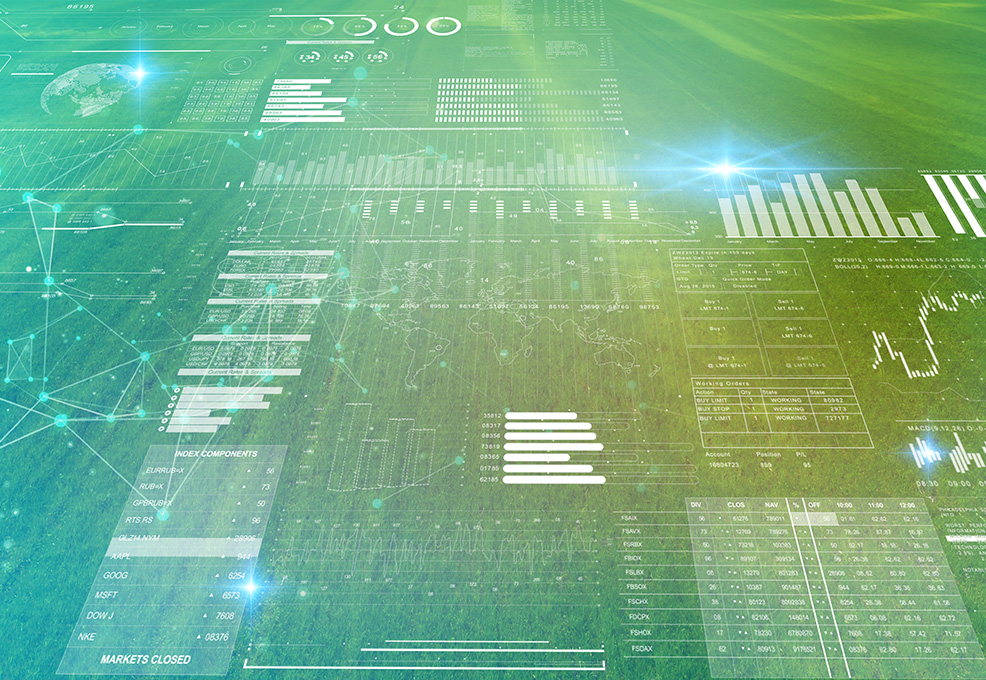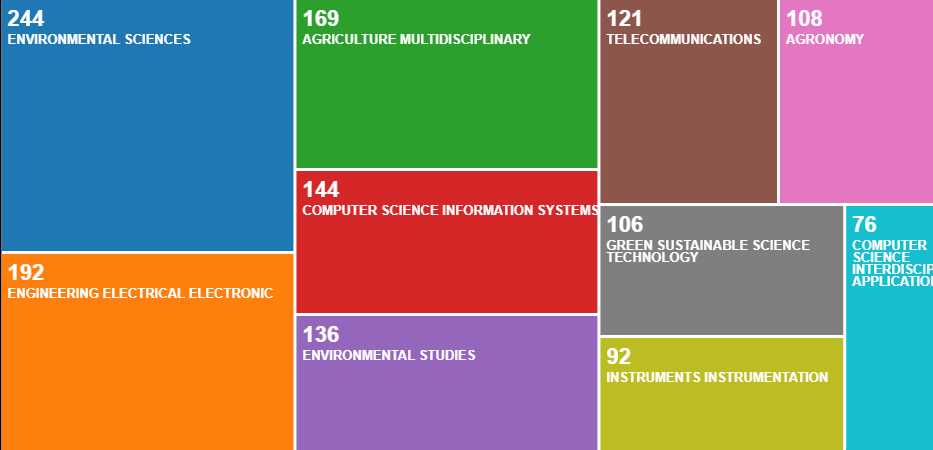The Rise and Shine of III-V Compound Semiconductors – Evolution of 5G and Sub 6G Communication

- ENGINEERING & TECHNOLOGIES
- Text & Image
- May 18,2021
In the past, agriculture was an important industry supporting Taiwan’s economy. With the development of industrialization, the national economy has gradually switched to being primarily based on manufacturing and commerce; however, agriculture still plays an indispensable role in our lives. In recent years, with the integration of emerging technologies such as artificial intelligence, big data, and environmental monitoring, traditional agriculture has transformed from the weather-dependent industry of the past, to smart agriculture with multidisciplinary, multiregional cooperation and development.
The concept of smart agriculture can be traced back to the United States and European countries in the 1980s. At that time, they used modern information technology, such as GPS, GIS, remote sensing, and spectral detection to collect large amounts of data about soil environment, microclimate conditions, etc. These data were used to develop precision agriculture to apply the best-suited irrigation and fertilization measures to each piece of farmland and increase crop yields (Peng, 2018). Facing the new challenges of globalization, climate change, and population aging, emerging technologies related to automation, smart technology, and the Internet of Things (IoT) have been widely used in agriculture in recent years to create a smart agriculture that is even more advanced than the precision agriculture of the past.
Global Trends in New Agricultural Science Research
When entering the keyword “intelligent agriculture” into the Web of Science’s global citation database, 1437 pieces of papers related to the topic were found. Further analysis of these papers shows that most papers on intelligent agriculture from 2016 to 2020 were related to the topic of Environmental Sciences (16.98%), followed by Engineering, Electrical & Electronic (13.36%), and Agriculture, Multidisciplinary (11.76%). It can therefore be estimated that most new agriculture research is on research and applications for agricultural land and environments, and on electronic and electrical tools (see Figure 1).
It is worth noting that among new agriculture papers, papers related to computer science and multidisciplinary applications accounts for approximately 15.30% of the whole. This could be the result of the fact that computer science, big data and the IoT have often been used in agricultural intelligence in recent years. In addition, the data shows that more and more new agricultural research is focusing on issues related to green energy and sustainability (7.38%). This indicates that new agriculture is not only the application and improvement of new technology in traditional agriculture, but also covers issues related to the environment and humanities.

Figure 1. Distribution of research fields for papers on intelligent agriculture, 2016 to 2020 (source: Web of Science database)
Influence of Intelligent Agriculture’s Development on Agricultural Technology
Due to the impact of aging populations, labor force reduction, and climate change, how to apply new technology to obtain higher-quality crops with higher efficiencies has become the main goal of new agriculture development. In recent years, the development of intelligent agriculture has focused on the application of artificial intelligence and digital services in agriculture (Agricultural Technology Decision Information Platform, 2019). These applications can be divided into the four categories: agricultural robots; crop and soil monitoring; prediction and analysis of crop growth and agricultural land use; and introduction of blockchain technology into agricultural product supply chain.
The design and development of automatic robots and programs can help farmers handle basic agricultural tasks and lessen labor shortage problems arising from lower birth rates and aging populations. Technologies that have already been developed and put into worldwide use include weed control robots driven by solar energy, agricultural crop robot, robotic lawnmowers, etc. In addition, German and American agricultural technology companies have developed and used big data analysis and deep learning to record the environmental status of agricultural soil to seek the most appropriate farming methods. In forecasting and analyzing crop growth and land use, an R&D team has used machine learning models and satellite weather forecasting to track weather and forecast crop yields (Chang, 2019). Finally, the introduction of blockchain technology is helping farmers to integrate different agricultural materials and resources, and help track agricultural products’ life-cycle and trace seed sources, making agricultural products’ journeys, from soil to sale, more transparent (Tu, 2021).
Among the countries that are developing new agriculture, Israel faces particular restrictions on natural resources and environment. As such, Israel has to use new agriculture to maximize and optimize existing resources, fertilizers, water for irrigation, and crop growth. To achieve these goals, the country is employing cutting-edge AIoT and Internet technologies, and developing key agricultural technologies such as the drip irrigation system, drought resistant melons, and harvesting machines. The Israeli government actively develops smart agricultural with precise agricultural characteristics by cooperating with multinational teams. For example, the Israeli research team collaborated with teams from Sweden and Belgium to jointly develop a smart robot that can identify outlooks and maturities of green peppers with AI algorithm, and determine whether the vegetables are ready to be harvested before operation (Chen, et al., 2020).
Current Status and Directions for Taiwan’s New Agriculture
New agriculture is a part of the Government's "5 + 2 Industrial Innovation Plan". Unlike the United States and European countries that have large land areas for cultivation, Taiwan has limited farming area and nature resources. So, the government is actively looking for new agricultural technologies that are best suited to Taiwan. The Executive Yuan’s Council of Agriculture has been promoting smart agriculture since 2017, and government, industry and academia alike have cooperated to promote farmers' investment in new agriculture. The development of smart agriculture focuses on "smart production" and "digital service", with the intention of using intelligent production management to improve production efficiency and capacity of agriculture. In addition, it is hoped that smart agriculture can develop into an Efficiency, Safety, and Low Risk industry with new models of agricultural management basing on the IoT and big data analysis, active and all-round agricultural purchase and service platforms (New Agricultural Innovation Promotion Program of the Executive Yuan, 2020).
With guidance from the government, Taiwan has made considerable achievements in R&D for new agricultural technologies. From big data analysis to UAVs, intelligent equipment and environmental monitoring system, Taiwan has already achieved results that are being rolled out within the industry. One example of applying AI and UAVs to intelligent agriculture is the CX180 intelligent unmanned helicopter jointly developed by Thunder Tiger Technology and the Feng Chia University’s Department of Aerospace and Systems Engineering. The CX180 is capable of carrying out pesticide spraying and agricultural environment monitoring (Chang, 2019).
In addition to intelligent agricultural technology, with increasing attention paid to the topic of environmental sustainability, sustainable new agriculture has also become a hot topic. The Innovation and New Industrial Models for Zero-Waste Agricultural Carbonization Technology project, managed by the Taiwan Forestry Research Institute of the Executive Yuan’s Council of Agriculture (Chuang, 2017), focuses on development of applications for carbonized agricultural surplus materials. In addition to solving the problem of clearing and transporting discarded agricultural materials and environmental pollution, this project promotes the emergence of a service industry for farmers on environmental protection information and materials.
It is crucial for the research and development of new agricultural technology aligns with the country’s topography and agricultural customs in order to develop the most appropriate technology. Taiwan has a solid technological foundation in computer science, engineering, and industrial R&D strengthen. Taiwan’s agriculture also has a long history of development. Combining these strengths and the new agricultural development focuses on “Innovation, Employment, Distribution, and Sustainability”, Taiwan has developed its own unique, new agricultural technologies with high potential for further development.
References
- Executive Yuan (2020), New Agricultural Innovation Promotion Program, Taipei: Press and Communication Department of the Executive Yuan.
- Tu, Tsui-Shan (2021), Blockchain Can Trace Seed Sources: A Further Step in Agricultural Application. DIGITIMES.
- Chang, Hsiao-Mei (2019), Using AI and Blockchain to Create the New Agricultural Economy. Technological Policy Viewpoint, Taipei: National Experimental Research Institute.
- Chuang, An-Hua (2017), Circular Agriculture Extends the Value of New Agriculture. Harvest Magazine, No. 12, Vol. 67, doi:10.6708/harvest.201712_ 67(12).0019
- Chen, Yu-Hong, et al., (2020), Learning from Other People’s Experience: Israel's New Agricultural Development Experience and Development Opportunities for Taiwan. Agricultural Media.
- Peng, Ssu-Yuan (2018), New Agriculture + New Southbound Policy: The Efficacy of 1 + 1 Is Greater Than 2. Taiwan Economic Research Monthly, pp. 15-22.
- Agricultural Technology Decision Information Platform (2018), accessed at: https://agritech-foresight.atri.org.tw/article/list/13
STAY CONNECTED. SUBSCRIBE TO OUR NEWSLETTER.
Add your information below to receive daily updates.




